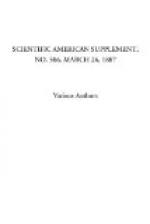Once, during a meeting of the Kansas Academy of Science, at Lawrence, Professor Snow was advertised to read a paper on some rare species of butterflies. As the hour approached, the hall in the university building was thronged, principally by ladies from the city, when Professor Snow brought out piles of his trays of butterflies, and without a note gave such an exhibit and description of his specimens as charmed the whole audience.
In meteorology, Professor Snow is an acknowledged authority, wherever this science is studied, and he has, probably, all things considered, the best meteorological record in the State.
Personally, Professor Snow possesses qualities that are worth more, perhaps, to his pupils, in forming character, than the knowledge derived from him as an instructor. His life is pure and ennobling, his presence inspiring, and many young men have gone from his lecture room to hold good positions in the scientific world. When one sees him in his own home, surrounded by his family, with books and specimens and instruments all around, he feels that the ideal home has not lost everything in the fall.
Snow Hall is the natural resultant of twenty years of earnest and faithful labor on the part of this eminent scientist. The regents displayed the rare good sense of committing everything regarding the plans of the building, and the form and arrangement of the cases, to Professor Snow, which has resulted in giving to Kansas the model building of its kind in the West, if not in this country. Very large collections have accumulated at the State University, under the labors of Professor Snow and his assistants, which need to be classified, arranged, and labeled; and when the legislature appropriates the money to furnish cases to display this collection in almost every department of natural science, Kansas will possess a hall of natural science whose influence will be felt throughout the State, and be an attraction to scientists everywhere.—Chaplain J.D. Parker, in Kansas City Journal.
* * * * *
ELIMINATION OF POISONS.
A study of the means by which nature rids the economy of what is harmful has been made by Sanquirico, of Siena, and his experiments and conclusions are as follows:
He finds that the vessels of the body, without undergoing extensive structural alteration, can by exosmosis rid themselves of fluid to an amount of eight per cent. of the body weight of the subject of the experiment.




